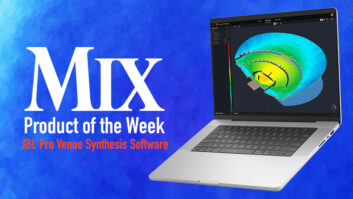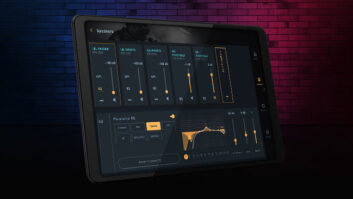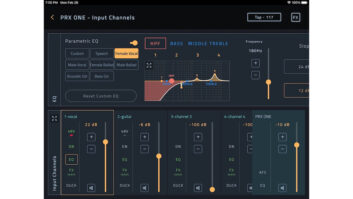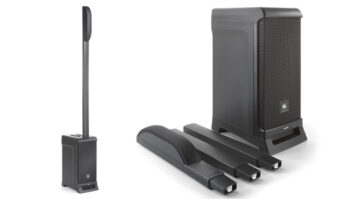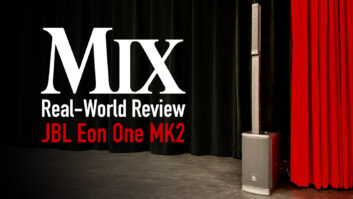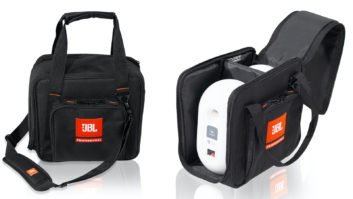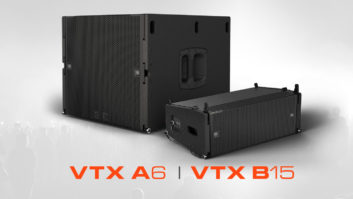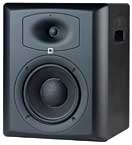

Five years ago, Mix checked out JBL’s award-winning LSR (Linear Spatial Reference) Series monitors. Designed for stereo listening (with or without a matching subwoofer) or full 5.1 monitoring, the LSR Series were by far the best powered near/mid-field speakers JBL had produced. Unfortunately, they were designed around a woven carbon-fiber front baffle, which was beautiful but nearly impossible to build in quantity. After enduring months of back orders, JBL embarked on a new generation of LSRs that takes the approach to studio monitors beyond anything that had been attempted.
The new series addresses the problem of room acoustics caused by the physical properties of the space. This THXpm3®-approved series has four models: the LSR6328P, a bi-amplified system with 8-inch woofer and 1-inch tweeter; the LSR6312SP powered sub; the LSR6325P biamped with 5.5-inch LF and 1-inch tweeter; and the unpowered three-way LSR6332 with a 12-inch woofer, 5-inch mid and 1-inch tweeter.
Designed to counteract the boomy LF standing waves created by a room’s geometry, the LSR6328P and the LSR6312SP feature RMC™ (Room Mode Correction) circuits. An accessory RMC calibration kit provides everything needed to measure the room response, identify the dominant room mode and calibrate system response. The kit includes a test-tone CD and a simple handheld SPL meter to set the integral 22 bands of 1/10th-octave analog parametric filters that notch out offending frequencies.
The RMC is focused on fixing low-frequency (24 Hz to 96 Hz) anomalies, such as reflection-caused room modes that create peaks at the listening position. While the system doesn’t affect mids or high frequencies (other than the DIP switches to set up shelving cut/boost), these are the segments of the audio spectrum that are easiest to treat with absorbers, foam, diffusers, etc. — products from dozens of suppliers to handle such problems. The LSR6328P also has boundary-compensation filters for use when the speaker is placed/mounted on a wall, corner or large furniture surface. At 39 pounds, the 16×13×12.75-inch LSR6328P is enough to crimp a weak console meter bridge. Monitor stands will sound better and allow placements that avoid (or reduce) the effect of console reflections and mechanical resonance.
Beyond the LSR6328P’s and LSR6312SP’s RMC functions, there are numerous nice new touches. The LSR6328Ps have recessed side handles (near-fields do get moved around a bit) and reinforced mounting points for optional wall-mount hardware. The new electronics offer a cleaner sound with no discernable noise while idling.
The LSR6312SP sub puts a 12-inch Differential Drive® neodymium woofer in a 25×15.5×11.5-inch (W×H×D), front-ported enclosure with 260-watt amp, integrated bass management (for stereo or surround), a direct LFE input, a mono summed out for daisy-chaining another LSR6312SP sub and the onboard RMC circuitry. There are inputs and outputs for connecting your left/center/right (or left/right in stereo) monitors directly with the sub. By connecting a simple SPST footswitch to the sub’s ¼-inch LCR bypass jack, the mains can be remotely switched out of the sub’s bass-management crossover. Another ¼-inch jack is for an RMC bypass (a small handheld switch is included with the calibration kit), along with four trimpots for adjusting the RMC parameters (width/frequency/depth/makeup gain). All audio connections use Neutrik combo XLR/TRS (on the inputs) and XLR-Ms on the outs. Inputs are shipped at a -10dBV sensitivity, but are switchable to 0/+4/+8/+12 dBu.
IN THE STUDIO
In addition to the RMC functions, the LSR6328P has continuously variable attenuation. The pot has no detents, making exact level-matching between monitors difficult, but a rear panel 8-position DIP switch next to the pot can defeat the rotary control for selectable sensitivity with precise 0/-4/-8/-12 dB of attenuation. Other DIPs provide subsonic attenuation: two settings for ±1 dB of gentle slope HF shelving, and -1.5/-3/-4.5dB LF boundary compensation. The latter is useful when speakers are placed near walls or corners, but can also adjust for the bass boosting caused by nearby worksurfaces and console tops. In a semi-free field environment (on stands behind the console), the LSR6328Ps sounded fine with the DIP switches in the flat, no roll-off position.
The LSR28P’s 8-inch carbon-fiber cone woofer (driven by a 250W amp) also features JBL’s Differential Drive design. Here, two voice coils drive the cone and a third coil acts as an electromagnetic dynamic brake, actively slowing the cone action in extreme SPL situations where over-excursion could destroy the woofer. This combo works great. Miking a 22-inch rock kick with an Audix D6 placed just inside the drum sounded identical in the control room as in the room: a tight, punchy slap with plenty of boom, yet no overshoot.
On the top end, a 120W amp drives the 1-inch composite/titanium-dome tweeter (now mag-shielded!) on an Elliptical Oblate Spheroidal waveguide. Recording HF-intense sources — banjo, piano and 12-string — with a pair of Royer SF-1 ribbons, the top-end character was spot-on: unhyped and natural. On tough percussive sources — chromatic crotales and triangle — transients rang through clear and present. The waveguide offered smooth, controlled dispersion for a medium-wide sweet spot at the listening position. I never had that “Where did the sound go?” experience when reaching for an EQ. The stereo imaging was tight and precise to the point where a 1:00 to 2:00 move on a snare panpot in a multitrack mix provided a meaningful change, while stereo-miked sources — solo and ensemble — had a “you are there” feel.
The LSR6328Ps have the same character as the LSR28P’s unhyped, flat reproduction, with natural high frequencies, well-defined solid bass (with or without the sub) and an unfatigued sound, even after hours of listening. Mixing voices — music cuts and narration — the spectral balance was spot-on, translating well in the critical lower vocal range and with a seamless transition across the 1.7kHz crossover.
The real excitement of the new LSR system comes from the Room Mode Correction functions. Accessing these functions requires the $130 RMC kit (included free with the sub or a pair of LSR6328Ps). The system works fine without the RMC kit, especially if you work in a studio with ideal acoustics. But the RMC goes a long way toward improving the response of less-than-ideal rooms, especially smaller budget spaces.
The half-hour RMC setup routine is easy with step-by-step instructions. The handheld sound level meter is a slick little device with a built-in calibrated mic and a backlit scale with a 16dB range. Calibration simply involved playing a CD of warble tones on 1/10th-octave centers, using the test meter to measure the peak of each tone and marking the results on a chart. The approximate Q of each peak is entered into the width control on the rear of the speakers. Like the width values, the values for center frequency and 0 to -14dB attenuation are also entered into the speaker’s RMC controls. The entire process is much simpler to do than to describe.
The first room where I tried the speakers sounded okay at first, but with the RMC, the bass tightened up, the LF mush disappeared and the bass had definition and clarity. This (acoustically) troublesome 11×17-foot project room had a nasty 4dB bump at around 60 Hz and the RMC took it out surgically and cleanly, without killing the bass or destroying the mix. When I moved to a 20×30-foot room with a 15-foot ceiling — a nearly free-field environment — I barely needed any RMC, but few of us ever have the luxury of mixing in nice large rooms. Mixing in much smaller rooms, the RMC removed nasty room bumps, leaving me with a transparent, uncolored mix environment that translated anywhere with the power for high-energy rock or hip hop with room-shaking bass that was solid down to 35 Hz.
So far, so good, but going first class doesn’t come cheap. The LSR6328Ps retail at $1,399 each; the LSR6312SP is $1,499; and JBL offers special pair ($2,678) and 5.1 system ($7,775) prices that include RMC. Either way, JBL has delivered a powerful solution to room correction in a system that will set standards for years to come.
JBL Professional, 818/894-8850, www.jblpro.com.

• For online product training, and a cool demo of the LSR6300 Series,
click here.
